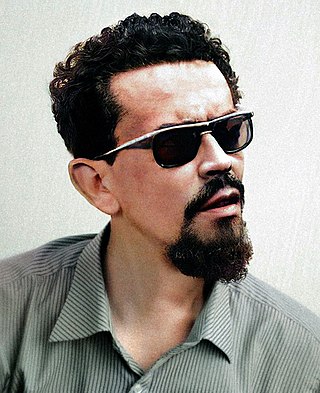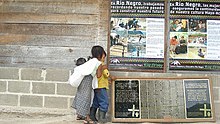
The Contras were the various U.S.-backed and funded right-wing rebel groups that were active from 1979 to 1990 in opposition to the Marxist Sandinista Junta of National Reconstruction Government in Nicaragua, which had come to power in 1979 following the Nicaraguan Revolution. Among the separate contra groups, the Nicaraguan Democratic Force (FDN) emerged as the largest by far. In 1987, virtually all Contra organizations were united, at least nominally, into the Nicaraguan Resistance.
Nicaragua is a nation in Central America. It is located about midway between Mexico and Colombia, bordered by Honduras to the north and Costa Rica to the south. Nicaragua ranges from the Caribbean Sea on the nation's east coast, and the Pacific Ocean bordering the west. Nicaragua also possesses a series of islands and cays located in the Caribbean Sea.

The Republic of Nicaragua v. The United States of America (1986) was a case where the International Court of Justice (ICJ) held that the U.S. had violated international law by supporting the Contras in their rebellion against the Sandinistas and by mining Nicaragua's harbors. The case was decided in favor of Nicaragua and against the United States with the awarding of reparations to Nicaragua.

Central America is commonly said to include Guatemala, Belize, El Salvador, Honduras, Nicaragua, Costa Rica, and Panama. This definition matches modern political borders. Central America begins geographically in Mexico, at the Isthmus of Tehuantepec, Mexico's narrowest point, and the former country of Yucatán (1841–1848) was part of Central America. At the other end, before its independence in 1903 Panama was part of South America, as it was a Department of Colombia. At times Belize, a British colony until 1981, where English instead of Spanish is spoken, and where the population is primarily of African origin, has been considered not part of (Spanish-speaking) Central America.

The Nicaraguan Revolution encompassed the rising opposition to the Somoza dictatorship in the 1960s and 1970s, the campaign led by the Sandinista National Liberation Front (FSLN) to oust the dictatorship in 1978–79, the subsequent efforts of the FSLN to govern Nicaragua from 1979 to 1990, and the Contra War, which was waged between the FSLN-led government of Nicaragua and the United States–backed Contras from 1981 to 1990. The revolution marked a significant period in the history of Nicaragua and revealed the country as one of the major proxy war battlegrounds of the Cold War, attracting much international attention.

Chalatenango is a department of El Salvador located in the northwest of the country. The department's capital city is the city of Chalatenango, which shares the same name as the department. Chalatenango covers a land area of 779 sq mi and contains over 192,000 inhabitants. Chalatenango's maximum elevation, located at Cerro El Pital, is 8,960 feet (2,730 m).

Carlos Fonseca Amador was a Nicaraguan teacher, librarian and revolutionary who founded the Sandinista National Liberation Front (FSLN). Fonseca was later killed in the mountains of the Zelaya Department, Nicaragua, three years before the FSLN took power.

The National Reorganization Process was the military dictatorship that ruled Argentina from 1976 to 1983, which received support from the United States until 1982. In Argentina it is often known simply as the última junta militar, última dictadura militar or última dictadura cívico-militar, because there have been several in the country's history and no others since it ended.

The Guatemalan Civil War was a civil war in Guatemala fought from 1960 to 1996 between the government of Guatemala and various leftist rebel groups. The government forces have been condemned for committing genocide against the Maya population of Guatemala during the civil war and for widespread human rights violations against civilians. The context of the struggle was based on longstanding issues of unfair land distribution. Wealthy Guatemalans, mainly European-descended, and foreign companies such as the American United Fruit Company had dominated control over much of the land, and paid almost zero taxes in return – leading to conflicts with the rural indigenous poor who worked the land under miserable terms.
Operation Charly, was allegedly the code-name given to a program during the 1970s and 1980s undertaken by the junta in Argentina with the objective of providing military and counterinsurgency assistance to right-wing dictatorships and insurgents in Central America. According to Noam Chomsky, the operation was either headed by the Argentine military with the agreement of the United States Department of Defense, or was led by the US and used the Argentinians as a proxy.

This is an index of Central America-related articles. This index defines Central America as the seven nations of Belize, Costa Rica, El Salvador, Guatemala, Honduras, Nicaragua, and Panama.
The modern history of Honduras is replete with large-scale disappearances of left-leaning union members, students and others. The legislature approved a new constitution in 1982, and the Liberal Party government of President Roberto Suazo Córdova took office. Suazo relied on United States support — including controversial social and economic development projects sponsored by the United States Agency for International Development — during a severe economic recession. According to the US State Department, "Honduras became host to the largest Peace Corps mission in the world, and non-governmental and international voluntary agencies proliferated."
The Central American Resource Center (CARECEN) are two community-based organizations that seek to foster the comprehensive development of the Latino community. CARECEN in the Washington, D.C. metropolitan region was founded in 1981 to protect the rights of refugees arriving from conflict in Central America and to help ease their transition by providing legal services. CARECEN provides direct services in immigration, housing and citizenship while also promoting empowerment, civil rights advocacy and civic training for Latinos. Another CARECEN is also located in Los Angeles and which was established two years after the D.C. location.
José María Reyes Mata was a Honduran revolutionary sympathizer of Fidel Castro and trained as both a doctor and in internationalist revolutionary thought in Cuba. He participated in Che Guevara's ill-fated Bolivian revolution and after surviving prison moved to Chile. With the 1973 Chilean coup d'état, Reyes Mata returned to Honduras and fought with Nicaraguan Sandinistas, hoping to gain their support for a Revolutionary United Front to be established in Honduras. In 1983, he led a group of Honduran rebels from Nicaragua into Honduras and was captured by military forces. The date of his death remains unclear and his body has never been located.
The 1979 Salvadoran coup d'état was a military coup d'état that occurred in El Salvador on 15 October 1979. The coup, led by young military officers, bloodlessly overthrew military President Carlos Humberto Romero and sent him into exile. The National Conciliation Party's firm grasp on power was cut, and in its place, the military established the Revolutionary Government Junta of El Salvador (JRG). The junta was composed of two military officers and three civilians.

The following lists events that happened during 2020 in Central America: Belize, Costa Rica, El Salvador, Guatemala, Honduras, Nicaragua, and Panama.

The Santa Rita massacre occurred near the municipality of Santa Rita in Chalatenango, El Salvador, on 17 March 1982. During the massacre, soldiers from the Atonal Battalion attacked and killed four Dutch journalists and a disputed number of guerrillas from the Farabundo Martí National Liberation Front (FMLN).
The final offensive of 1981, also known as the general offensive of 1981, was the unsuccessful first military offensive conducted by the Farabundo Martí National Liberation Front (FMLN) during the Salvadoran Civil War. The objective of the offensive was to initiate a popular revolution to overthrow the Revolutionary Government Junta (JRG), which had been ruling the country since the 1979 Salvadoran coup d'état. The FMLN hoped that the government would be overthrown by 20 January 1981; the date Ronald Reagan was to be inaugurated as president of the United States.
The War of 1907 was a conflict fought between El Salvador and an alliance between Honduras, Nicaragua, Salvadoran exiles, and American filibusters. The invasion of El Salvador on 11 June 1907 resulted in a quick military victory for El Salvador as invading forces withdrew by the end of the day. The war officially ended with the signing of a peace treaty on 20 December 1907 which established the Central American Court of Justice.
Relations between the Greater Republic of Central America, also known as the United Provinces of Central America, and the United States were formally established in 1896 following El Salvador, Honduras, and Nicaragua agreeing to form a union similar to the former Federal Republic of Central America. Relations lasted until 1898 when the Great Republic dissolved and relations with the United States continued with the individual states of El Salvador, Honduras, and Nicaragua.













